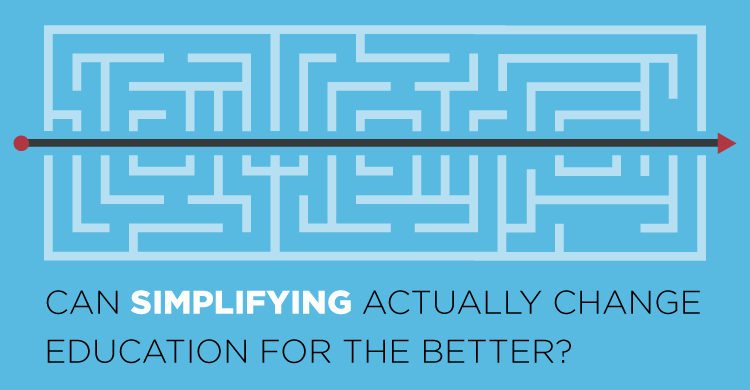Recently, a colleague of mine casually asked, “How are we encouraging creativity and innovation as a school?”
“Creativity and innovation?” I thought. “Educators are doing all they can just to keep all the spinning plates from crashing to the ground each year.”
The list of traditional challenges in today’s schools seems endless. And unprecedented historical events like the global pandemic introduced new difficulties, further burdening educators with overflowing responsibilities. The ever-evolving role of educators can seem overwhelming. I thought to myself, “How can schools be innovative and creative with so much piling up and, quite literally, changing daily?”
Suddenly, there it was. It was as if the fog in my brain momentarily lifted, and the figurative light bulb above my head lit up. The answer to the question was right in front of me: The creativity and innovation needed in today’s schools is not found in adding more but in simplifying and focusing.
Imagining a world of powerful what-ifs
As I sat lost in my thoughts, I began thinking about the endless list of vendor promises guaranteeing their new program would forever change learning in my school. I gazed at the unread emails in my overloaded inbox, begging to be opened.
My calendar was prominently demanding that I should have been at one of the 17 appointments scheduled for that day. But in the rush of this daily school noise, I momentarily didn’t care; my brain was on fire with this creative and innovative idea of addition by subtraction—by simplifying! I was lost in my thoughts.
What would schools look like if we just thought differently by focusing our efforts on proven high-leverage actions, ignoring the noise, and just simplifying? I was suddenly bursting with what-ifs:
- What if, instead of adding new programs or chasing shiny things year after year, we simplified and focused on identified high-leverage strategies proven to impact learning?
- What if, instead of feeling the pressure to get all the curriculum delivered, teacher-teams had permission to prioritize the focus for their instruction by collectively identifying, clarifying, and ensuring the essentials all students must learn in each course and grade level?
- What if, instead of students completing assignments to collect points to exchange for an ambiguous letter, students were able to clearly articulate what it is they are learning and where they are in the learning process?
- What if, instead of assessments being used as a score in the gradebook, we focused more on the powerful practice of using assessments for feedback and a tool for educators to learn from together?
- What if, instead of numerous mind-numbing meetings, we created targeted time for teachers to learn together by discovering the impact of their own shared best practices?
The answer
The answer to adding more creativity and innovation in our schools today is paradoxically to simplify and focus, with the idea of learning together as a cornerstone of our work.
It seems so powerfully simple.
Leveraging the magic of simplicity
As I considered this, I reflected on the many lessons I’d learned about the power of simplicity. Many years ago, when I was a new high school teacher and coach, I became keenly aware of a small school in our state that would consistently dominate much larger schools on the football field. Year after year, this team would resoundingly defeat these much larger, more athletically talented rosters. I decided there was something to learn there! I sought out the coach of this school with the intention of acquiring some mystical play or secret strategy that would help me as a brand-new educator and coach. After some preliminary small talk and predictably ambiguous advice, he shared a pearl of wisdom with me:
“We don’t have the athletes that big schools do. While other schools focus on running 80–90 plays, and running them pretty well, we have 12 foundational plays, and we run them excellently. From the time the kids enter our program in the 9th grade until they depart as seniors, we run the same 12 plays as our foundation. If we do this well, the scoreboard will take care of itself. The key is that we focus our efforts on these 12 plays and execute them perfectly.”
And there it was, my first hint of the effectiveness of excelling in simplicity. From this early lesson and through the years, I’ve realized the impact of harnessing the power of simplicity and the need for this in our schools today. Dr. Robert Eaker, one of the brilliant architects of the professional learning communities process, reaffirmed the need for focusing on high-leverage, doable strategies when he observed, “When it comes to learning for all students, I have tried to filter my ideas through the prism of, ‘Does it work and is it doable?’” (Eaker, 2020).
Removing the noise in order to focus on what’s important
With this in mind, my colleagues and I felt compelled to share simple and doable actions teams can employ that can positively impact their collective work. Anchored in the four critical questions and three big ideas of professional learning communities, we outlined six simple and doable actions that teacher teams can take to positively impact student and team learning.
So here it is, my lightbulb moment; in this educational age of “new normals,” flashier programs, fancier technology, and ever-changing educational venues, we DO need to commit to being more creative and innovative by reducing the educational noise surrounding today’s amazing educators and providing the necessary time to focus on simple and doable practices that are proven to have a significant impact on student learning and increased teacher efficacy. Less really is more in today’s ever-changing educational landscape.
The answer to the question truly is . . . simple.
About the author
Bob Sonju is an award-winning educational leader, author, and speaker who is nationally recognized for his energetic commitment to coaching teacher teams and educational leaders in simple, doable processes and systems that create the conditions for lasting success. He is the author of Simplifying the Journey: Six Steps to Schoolwide Collaboration, Consistency, and Clarity in a PLC at Work® and many other titles.







